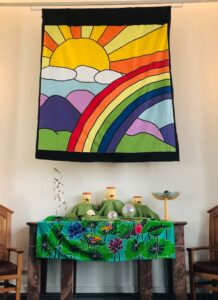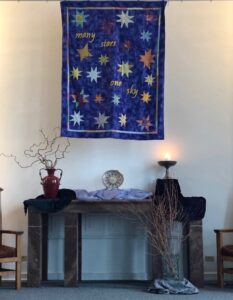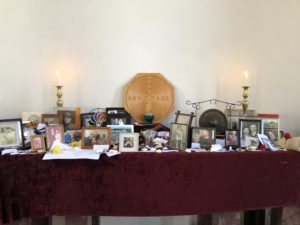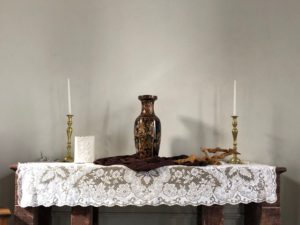Like so many things, there are deep roots to Mother’s Day (and yes, the placement of that apostrophe after the “r” and before the “s” is important to story).
During the 19th century, there have been several attempts by women’s peace groups to establish a holiday which celebrated peace, rather than war. It was not uncommon, for instance, for mothers whose sons had fought or died on opposite sides of the Civil War to gather and speak out against the horrors of war. Getting more specific, in 1868 a woman named Ann Jarvis sought to establish a “Mother’s Friendship Day,” which was intended as a day to “reunite families that had been divided [by the war].” (Jarvis had previously organized “Mother’s Day Work Clubs” which worked to improve conditions for both Union and Confederate encampments.) She wanted to expand Mother’s Friendship Day to become a celebration of all mothers, annually, but she died before she could do so.
In 1872, Julia Ward Howe led a “Mother’s Day for Peace” rally in New York City. Howe – author of “The Battle Hymn of the Republic,” and a Unitarian (I might add) – gave a speech that has come to be known “Mother’s Day Proclamation” (an excerpt of which can be found in the back of the hymnal at #573). In it she rails against, “the ambition of rulers [that] has been allowed to barter the dear interests of domestic life for the bloody exchanges of the battle field.” She’s clear about whose fault that is. She continued,
“Thus men have done. Thus men will do. But women need no longer be made a party to proceedings which fill the globe with grief and horror. … [T]he mother has a sacred and commanding word to say to the sons who owe their life to her suffering. […]
We will not have great questions decided by irrelevant agencies. [Here’s my favorite part!] Our husbands shall not come to us, reeking with carnage, for caresses and applause. Our sons shall not be taken from us to unlearn all that we have been able to teach them of charity, mercy and patience. We, women of one country, will be too tender of those of another country, to allow our sons to be trained to injure theirs. […] As men have often forsaken the plough and the anvil at the summons of war, let women now leave all that may be left of home for a great and earnest day of council.”
I’d like to see Hallmark make a card out of that! I imagine that on the front would be a picture of a woman, sitting on the edge of her bed. Inside it would read, “You shall not come to me, reeking with carnage, for caresses and applause. … Happy Mother’s Day!”
So … how did Hallmark get involved? Well, remember Ann Jarvis and her desire for a day to honor all mothers? After her death in 1905, Jarvis’ daughter, Anna Jarvis, picked up the cause. She campaigned mightily, and in 1910 Mother’s Day was declared an annual holiday … in West Virginia. Four years later, Congress designated the second Sunday in May as Mother’s Day, and President Woodrow Wilson issued a proclamation calling on American Citizens to show the flag in honor of all the mothers whose sons had died in war. (Again, an anti-war theme that doesn’t show up in the card aisle of CVS. But maybe PAUN– our Peace Action / United Nations – group might want to create an annual event here. Hmmm ….)
That apostrophe after the “r” and before the “s” is important, because Jarvis envisioned the holiday a little differently, she wanted it to be a day to honor “the best mother who ever lived [singular] – yours.” Yet soon this day to celebrate our own, individual, mothers became commercialized – fancy cards, expensive flowers, candy, gifts, became de rigueur.
And if you think we, today, want to push back against Mother’s Day’s over-the-top commercialization, you should have seen Anna Jarvis. She wrote,
A printed card means nothing except that you are too lazy to write to the woman who has done more for you than anyone in the world. And candy! You take a box to Mother – and then eat most of it yourself.
The woman who organized a petition to get Mother’s Day recognized as a national holiday organized a petition to put an end to Mother’s Day as an official holiday. Apparently she did a little civil disobedience, too, because she was arrested – more than once – for making a public disturbance. All of this seems to have been too much for her, and she was placed in the Marshall Square Sanitarium. She was kept in the Marshall Square Sanitarium by people connected with the floral and greeting card industries, who paid her bills. (And, again, let’s see what you can do with that, Hallmark!)
So … with all of this history about Mother’s Day, how does Mother Earth come in? Why is this service dedicated to Mother Earth rather than, you know, actual mothers? Well, Mother’s Day can be a hard one for a lot of folks. Some of us had a great relationship with our mother; some of us still do. Yet some grew up in abusive homes, and have nothing to celebrate. There are children who are estranged from their mothers, and mothers who are estranged from their children. Some of us wanted terribly to be mothers – some of us want terribly to be mothers – yet for any number of reasons motherhood has eluded us. Some mothers’ children have died – whether in the womb, during childhood, or at some time after that. Some of us have had abortions, knowing it was the right thing to do, yet mourning all the same. And, of course, some of us have never wanted anything to do with motherhood.
Like I said – Mother’s Day can be a hard one for some folks.
Yet I think that on days such as this, while there may be an element of specific particularity to it – “the greatest mother who ever lived, yours” – there is also a way that we’re tapping into the archetypal – “The Mother”. We all – all of us, and all things that have been, are, and ever will be – come from somewhere. We say that great ideas are “born.” There is a “maternal” dimension to our existence, and even when we’re thinking of our own, human – maybe “all too human” – mothers, we, perhaps even unconsciously, measure them, and ourselves as mothers, against that yardstick. And it is this understanding of “the maternal” quality of existence, of the Archetypal Mother, that allows us to recognize that there are all kinds of mothers, all kinds of mothering, that has shaped us, and through which we shape others.
Perhaps the most fundamental vision of The Mother is what we might call “The First Mother” – Gaia, Mother Earth. “The earth is our Mother / we must take care of her / the earth is our Mother / we must take care of her.” We just sang that primal understanding. “Her sacred ground we walk upon / with every step we take / Her sacred ground we walk upon / with every step we take.”
The Mother – the archetype of Motherhood, the fundamentally maternal aspect of reality – gives birth to us and to everything that is, ever was, and ever will be. It nurtures us, gives of itself, offers us opportunities to thrive and grow, and makes of us, truly, one human family. As anyone who’s ever sought out the beach, or the mountains, or the woods during times of confusion and pain can attest – we can turn to our Mother Earth when we have physical, emotional, or psychic “boo boos” that need a kiss to “make it all better.” The earth is our Mother / she will take care of us / the Earth is our Mother / she will take care of us.”
But we’re not doing such a good job of taking care of her, are we? A week ago Saturday, climate scientist announced that, “the concentration of carbon dioxide in the atmosphere has reached its highest level in at least 800,000 years.” This isn’t the highest level of CO2 our planet has seen. In what is sometimes called “the warm period” during the mid-Pliocene 3 million years ago, CO2 levels were also around 400 parts per million. But we know that at that time the Earth’s sea level was at least 66 feet higher than it is today. Scientists tell us that over the past century, our planet’s Global Mean Sea Level (GMSL) has risen by 4 to 8 inches. And it’s speeding up – the annual rate of rise over the past 20 years has been about twice the average speed of the preceding 80 years. Coastal cities in the US are making contingency plans, and smaller islands around the globe have already experienced devastating consequences from the rising seas.
“The earth is our Mother / we must take care of her / the earth is our Mother / we must take care of her.”
In 2010, a Green Sanctuary Task Force was created here, and through the hard and persistent efforts of a number of members – some of whom are here in the sanctuary this morning – our congregation completed 14 major projects and became a UUA certified “Green Sanctuary.” [If you were involved in any of these efforts, would you please rise or raise your hand?] Like so many things in a congregation’s life – in all our lives, probably, actually – a great deal of sweat and dogged determination goes into an achievement like that … and then that energy gradually dissipates and isn’t there to sustain that work. Oh, many of the things our Green Sanctuary Task Force led us in doing are still being done – and I strongly encourage you to go outside at some point during the social hour and check out our Green Sanctuary Arboretum! – yet so much has been forgotten.
So let us try to remember. Gaia, Mother Earth – whose “sacred ground we walk upon with every step we take,” whose holy breath we breathe with every breath we take – is very, very sick. Dying, some same. And we, her children, can’t be satisfied with the ecological equivalent of sending cards, and flowers, and candy (most of which we end up eating ourselves) once a year on Earth Day.
To all those who celebrate, or are celebrated on, Mother’s Day – Happy Mother’s Day. And to our sacred Mother Earth, from whom all things come, we’ll try to recommit ourselves to not simply celebrating, but truly honoring all the gifts you’ve given us – including the lives we now live – and to do so in every way we can, wherever we can, whenever we can, for as long as we can.
Pax tecum,
RevWik












